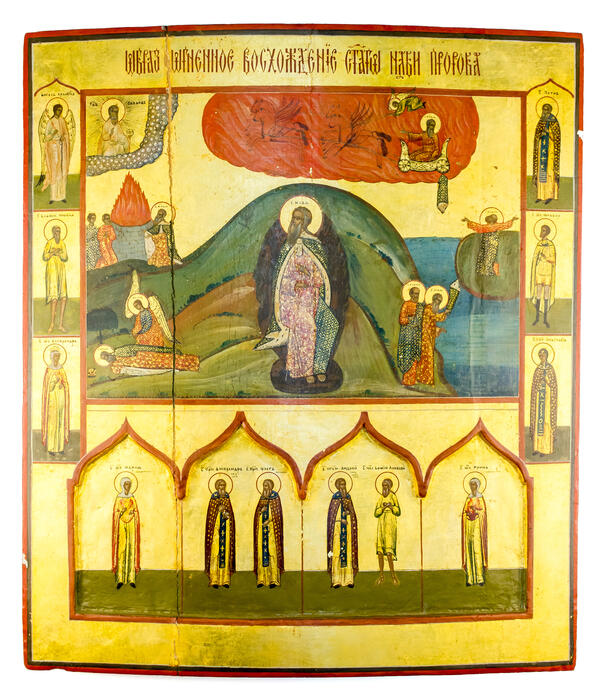The icon “The Fiery Ascension of Saint Elijah the Prophet” tells about the Old Testament righteous man who lived in the first half of the 9th century BC.
Saint Elijah dedicated his life to God and received a special gift: all his prayers got fulfilled. The prophet fought with the pagans and performed many miracles, and when his earthly service ended, he remained alive and was taken bodily into heaven, ascending in a fiery chariot.
The scenes in the centerpiece — the largest part of the icon — should be read from left to right, counterclockwise, starting from the altar with fire.
This part captures the episode when Elijah confronted Baal priests. In those years, King Ahab, who was married to a pagan queen Jezebel, ruled Israel. Jezebel strengthened her idol’s cult throughout the country, and began persecuting those who believed in one God. To punish the apostates, Elijah pleaded with God for three years of drought. And when the king was really frightened and was ready to listen to the prophet, he proposed to arrange a competition between him and the priests of Baal. It was decided to prepare two altars and pray for fire. The sacrifice that was to be accepted first without the priest lighting any fire would signify the true God.
Then a miracle happened: Elijah’s altar was on fire, the witnesses believed in the true God, and Elijah killed all the priests of Baal. Queen Jezebel got angry with him, and the saint had to flee to the mountains. He wanted to die there, but an Angel brought him water and food: the messenger of God told the saint to eat and drink and go to Mount Horeb. This episode is depicted in the second scene.
The largest scene in the centerpiece is dedicated to the moment when Elijah was talking to God on the mountain. After a strong wind, earthquake and fire, the Lord appeared to the prophet along with a quiet wind. He consoled him by telling him that Elijah was not alone: several thousand more Israelites had not agreed to worship Baal. Then He commanded Elijah to anoint God’s chosen people for the kingdom in Israel and Syria, and to find a disciple Elisha to replace himself.
Icon painters often depict another, very similar scene instead of the scene on Mount Horeb. During the drought, before meeting with the pagan priests, Saint Elijah hid from persecution at the Chorath stream near the Jordan River. So that he would not die of hunger, God told the ravens to bring him food. Therefore, icon painters often depict a large figure of the Prophet Elijah next to a raven.
The next scene in the chronology of the events features prophet Elijah crossing the Jordan River together with his disciple Elisha: he waves his cloak, and the waters part making a way in front of them.
The story ends with a scene of the prophet’s fiery ascension: he ascends in a heavenly chariot alive to God the Father.
Saint Elijah dedicated his life to God and received a special gift: all his prayers got fulfilled. The prophet fought with the pagans and performed many miracles, and when his earthly service ended, he remained alive and was taken bodily into heaven, ascending in a fiery chariot.
The scenes in the centerpiece — the largest part of the icon — should be read from left to right, counterclockwise, starting from the altar with fire.
This part captures the episode when Elijah confronted Baal priests. In those years, King Ahab, who was married to a pagan queen Jezebel, ruled Israel. Jezebel strengthened her idol’s cult throughout the country, and began persecuting those who believed in one God. To punish the apostates, Elijah pleaded with God for three years of drought. And when the king was really frightened and was ready to listen to the prophet, he proposed to arrange a competition between him and the priests of Baal. It was decided to prepare two altars and pray for fire. The sacrifice that was to be accepted first without the priest lighting any fire would signify the true God.
Then a miracle happened: Elijah’s altar was on fire, the witnesses believed in the true God, and Elijah killed all the priests of Baal. Queen Jezebel got angry with him, and the saint had to flee to the mountains. He wanted to die there, but an Angel brought him water and food: the messenger of God told the saint to eat and drink and go to Mount Horeb. This episode is depicted in the second scene.
The largest scene in the centerpiece is dedicated to the moment when Elijah was talking to God on the mountain. After a strong wind, earthquake and fire, the Lord appeared to the prophet along with a quiet wind. He consoled him by telling him that Elijah was not alone: several thousand more Israelites had not agreed to worship Baal. Then He commanded Elijah to anoint God’s chosen people for the kingdom in Israel and Syria, and to find a disciple Elisha to replace himself.
Icon painters often depict another, very similar scene instead of the scene on Mount Horeb. During the drought, before meeting with the pagan priests, Saint Elijah hid from persecution at the Chorath stream near the Jordan River. So that he would not die of hunger, God told the ravens to bring him food. Therefore, icon painters often depict a large figure of the Prophet Elijah next to a raven.
The next scene in the chronology of the events features prophet Elijah crossing the Jordan River together with his disciple Elisha: he waves his cloak, and the waters part making a way in front of them.
The story ends with a scene of the prophet’s fiery ascension: he ascends in a heavenly chariot alive to God the Father.



